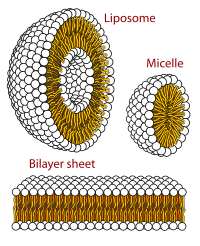
Photo from wikipedia
Abstract Copolymers consisted of anionic and neutral blocks can electrostatically complex to cationic surfactants forming a concentrated core, surrounded by a shell of hydrophilic blocks which stabilize nanoparticles in water.… Click to show full abstract
Abstract Copolymers consisted of anionic and neutral blocks can electrostatically complex to cationic surfactants forming a concentrated core, surrounded by a shell of hydrophilic blocks which stabilize nanoparticles in water. Cores are comprised of a phase concentrated in micelles and may even form liquid-crystalline structures and are expected to uptake superior amount of hydrophobic molecules than solutions of pure surfactant micelles. We prepared and characterized nanoparticles formed by hexadecyltrimethylammonium chloride and poly(ethylene oxide)-b-poly(methacrylic acid) of different block lengths to uptake hydrophobic ingredients for the first time. Scattering techniques were used to study effects on stability and core structure. Spectroscopy measurements were performed to confirm potential as hair sunscreen formulations. Oil uptake leads to higher ordering of micelles and is improved with increasing the length of anionic blocks. Long neutral blocks assure better dispersibility. The uptake of oil by nanoparticles can be twice their own concentration. It allows obtaining a sample with sunscreen protection factor of 15 and low viscosity to be sprayed over hydrophilic surfaces, where it is waterproof for at least 30 min. Samples containing essential oils with repellent or larvicide activity were also obtained. Results demonstrate the potential of these nanoparticles for dispersing oils in aqueous media, through a low-energy method.
Journal Title: Colloids and Surfaces A: Physicochemical and Engineering Aspects
Year Published: 2019
Link to full text (if available)
Share on Social Media: Sign Up to like & get
recommendations!